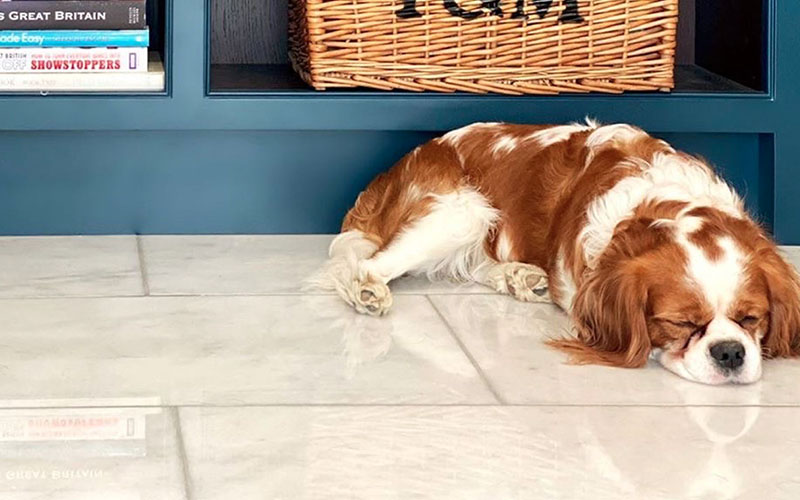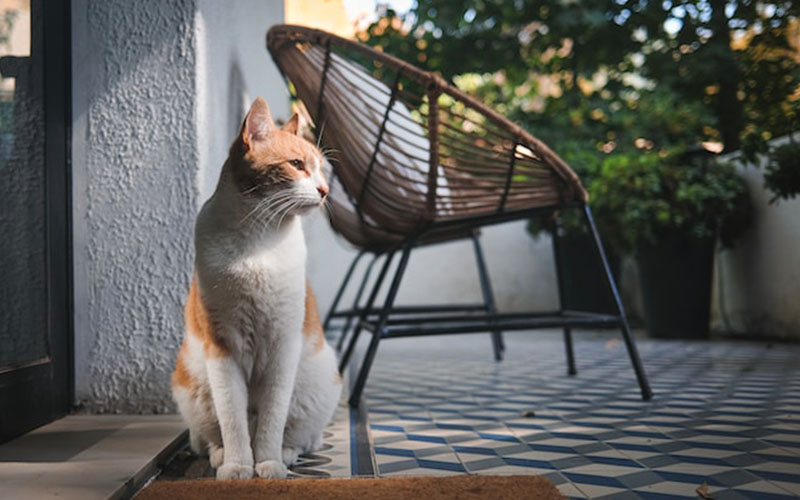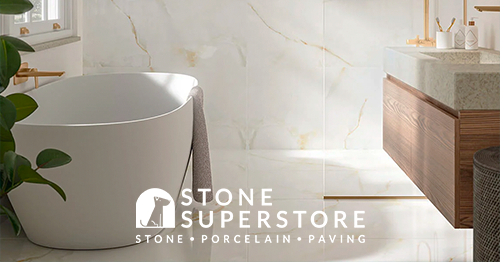Whether you’re a proud dog parent or feline fan, it goes without saying that our furry friends can leave plenty of mess and marks behind on our floors. From toilet-training accidents to mucky paw-prints and unintentional scratch marks, protecting your floors from daily dirt and pet-related grime can be quite a challenge.
That’s why it’s so important to have an understanding of the best flooring for dogs, cats, and more. Not only will the right surface underfoot make it that much easier to wipe away any soilage, but it can also stop your pets from injuring themselves due to sudden slips and slides.
So, to help you decide just which material is the best flooring to have with pets, we’ve listed out the pros and cons of all the various types of flooring you can expect to see in your home, as well as some handy tips to avoid your pets staining your floors to begin with.

What are the different flooring options for pets?
When it comes to good flooring for pets, you have quite the material range to choose from. Carpet, vinyl, tiles, and more, all of them have their pros and cons, however, if you want the best flooring for dogs and cats, you should look for something that’s durable, waterproof, stain-resistant, and easy to clean.
So, with that in mind, here is a breakdown of the different flooring materials you might want to consider:
Porcelain and natural stone tiles
When it comes to the best flooring for cats and dogs, natural stone and porcelain tiles often come top of the list – and for good reason.
Not only are these sorts of tiles extremely tough and durable, making them scratch and dent-resistant, but their solid surface makes them practically waterproof, so it’s easy to mop up any leftover urine or mud. Add to this their textured surface, and you can be sure that your pet won’t unintentionally start skidding from one side of the room to the other.
However, with that being said, tiles are not the cheapest of floor options, and not all tiles are created equally.
For the best results against your pet’s foot traffic, you’ll want to select a hard-wearing stone or porcelain, as softer stones, such as limestone, can be worn down over time. You’ll also need to be sure any natural stone tiles you have are sealed, otherwise, they could quickly absorb any stains and odours they’re exposed to.
Wood flooring
Much like tile flooring, wood floors are a practical choice, aesthetically pleasing, and easy to clean in most regards. They’re also much more durable than many other flooring options out there, though this is only the case if you settle on a hardwood material.
Unfortunately, despite being well-suited for use in a space with constant movement, wood is not ideal for all pets. For example, no matter what sort of wood you choose, any active cat or dog is going to scratch it one way or another, and there’s only so much that regular sanding can do before your planks start to look out of place.
Wood floors also come with the issue of easy staining and odour trapping. Even when varnished, urine has the habit of darkening your wood boards and leaving behind faint smells if you don’t catch it quickly. And while you could look to engineered wood to solve this issue, you likely find that this sort of design also suffers from the same issues.
Laminate flooring
Once one of the most popular pet flooring options out there, in recent years, laminate flooring has proven to be one of the worst flooring options for dogs and cats. Not only is it prone to staining and deforming, but laminate can often become swollen when exposed to excess moisture, as it’s only water-resistant, not waterproof.
On top of this, laminate flooring is slippery and not very scratch-resistant, so pet marks are going to visibly show up after a while, especially after accidental skidding and scrabbling. And unlike wood, you can’t sand down laminate flooring in order to remove these blemishes.
But with all that being said, laminate flooring is at least easy to clean, and it’s certainly one of the cheapest floor material options, making it somewhat suitable for those on a tight budget.
Vinyl flooring
Similar to laminate flooring, vinyl flooring is not the best flooring with pets. While it can look beautiful when laid correctly, it’s easily dented, gouged, and scratched if you’re not careful. As a result, it’s not the most physically durable material, and you may find you need to replace it after just a few years of use.
However, where vinyl does excel when compared to laminate flooring is in its ability to work anywhere in the home, as well as being entirely waterproof. This makes it very easy to clean up after your pets and you don’t need to worry about smells or staining becoming a long-term issue.
Carpets
Last, but not least, while they might be soft underfoot for our four-legged friends, carpets are not always ideal when living with pets. For one thing, they’re one of the worst flooring for dogs because of how absorbent they can be, making staining and persistent odours a potential inevitability, and they’re not the best flooring for cats due to regular scratching.
On top of this, carpets are very good at trapping allergens, which is likely to make any pet allergies worse, even when they’re out of the room. However, if carpets are what you’re after, then it’s best to choose a dark or patterned shade, as these are much better at masking any stains you can’t remove.
Which is the best tile material for pets?
If it’s not clear already, here at Stone Superstore, we’re definitely of the opinion that porcelain and natural stone tiling is the best flooring to have with pets thanks to its durability and waterproof nature. But which type of tile material is best suited for the roles?
On the one hand, porcelain certainly offers better surface protection due to its entirely sealed surface and non-porous nature, as well as being much easier to clean due to its entirely flat surface.
However, natural stone provides a much better grip underfoot, meaning your pets are far less likely to slip, and if sealed correctly, it can be just as resistant to scratches and stains as porcelain.
In other words, your choice of tile flooring is entirely up to you, and it really depends on what sort of tiles you think will work best in your home.

What is the best way to clean tile floors with pets?
Finally, if you already have tile flooring, then you might be wondering what the best way to clean tile floors with pets is.
Well, the good news is, thanks to the sealed nature of tile flooring, you can clean up pet mess as you would with any other tile dirt, though we would recommend using a pet-friendly cleaning product to protect your pets and ensure that all bacteria are removed.
Doing this also means you can target the dirty spot specifically, saving you from doing a full floor clean every time your dog or cat leaves muck behind. Just be sure the cleaner you choose is also a tile-friendly one, so you don’t damage your floors when scrubbing.
As for a more in-depth look into how to clean these sorts of indoor tiles, you can find the full breakdown in our blogs on how to clean natural stone tiles and porcelain tiles.
How can I stop my pets from making my floor dirty in the first place?
While it’s impossible for you to stop your pets from tracking in muck entirely, there are a few things you can do in your home to make cleaning up after them quick and easy:
- Always wipe up any mess they leave behind as soon as possible to prevent stains and odours – this is particularly important for any toilet-related accidents.
- Hoover regularly to stay on top of the battle against excessive pet hair
- Mop your floor regularly to prevent any dirt from building up
- Place mats under your pet’s bowls so that crumbs and water don’t hit the floor
- Scoop out your litterbox every day so that smells don’t accumulate
- Remember to reseal your floors every few years to keep them waterproof
With that out of the way, you should hopefully now have a much better idea of which sort of flooring you should choose to make cleaning up after your pets that much easier. And if you’re interested in buying any of our tiles, then get in touch with the team at Stone Superstore today.
We’ve an enormous range of tiles for you to choose from, including kitchen and bathroom tiles, so why not order a free sample of your favourites today? And in the meantime, browse more helpful articles like this to help you choose between natural stone and porcelain.

